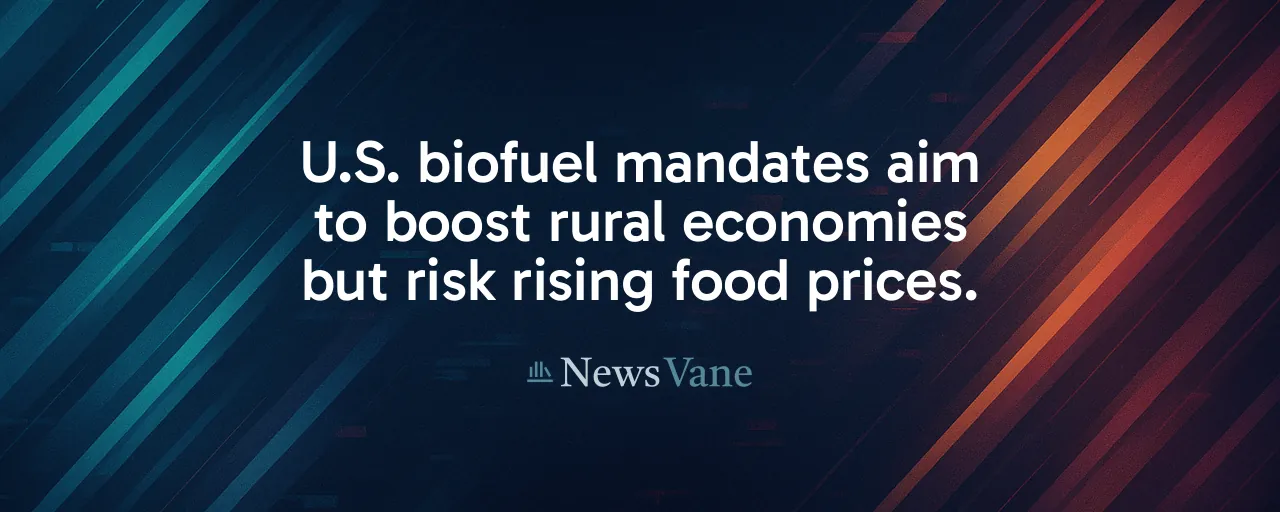A New Era for Biofuels
America is charging toward a biofuel-driven future. In June 2025, the Environmental Protection Agency unveiled its most aggressive Renewable Fuel Standard yet, targeting 24.46 billion gallons of renewable fuels by 2027. Backed by the Department of Agriculture, this policy aims to strengthen rural communities and reduce dependence on foreign oil. For corn and soybean farmers, it offers a steady market in a volatile world.
The idea has a long history. The Renewable Fuel Standard, launched in 2005, has long transformed crops into fuel, with roughly a third of U.S. corn and over 40 percent of soybean oil now powering vehicles. The latest plan, with a 75 percent increase in biomass-based diesel, shows the government is all in on this vision.
Farmers Win, Shoppers Pay
Rural America stands to gain. Higher biofuel targets drive up corn and soybean prices, padding farm incomes and boosting land values. Ethanol plants, supporting 55,000 direct jobs and 250,000 indirect ones, anchor Midwest economies. By prioritizing domestic feedstocks, the EPA could revive shuttered biodiesel facilities in places like Iowa, creating more local opportunities.
The flip side hits consumers hard. Diverting crops to fuel shrinks feed supplies, costing livestock producers an estimated $3 billion yearly, per USDA figures. Those costs pass through to grocery aisles, with EPA estimates suggesting the 2023-25 mandates could inflate food prices by $4.9 to $6.8 billion. For families already stretched thin, that's a real burden.
The Environmental Cost
Biofuels sound eco-friendly, but the reality is complicated. Corn ethanol, grown on 30 million acres, produces 24 percent more greenhouse gases than gasoline when land-use shifts are considered. Soy-based biodiesel can emit up to three times more than petroleum diesel. Since 2008, converting 4 to 5 million acres of grasslands and forests for crops has released carbon that could take decades to offset.
Water resources suffer too. Intensive farming for biofuels spikes nitrate pollution across 11,500 square miles of the Midwest, breaching safe drinking-water levels. Ethanol plants, emitting 17.4 million metric tons of CO2 equivalent in 2021, also tax aquifers like the Ogallala, which faces 69 percent depletion by 2060. These impacts question biofuels' green credentials.
Global Trade and Energy Goals
Biofuels are also a U.S. export success, reaching $5.11 billion in 2024. A new U.K. trade deal could add $700 million in ethanol sales, while the EPA's move to limit credits for foreign feedstocks bolsters domestic producers. Small refiners, however, warn that compliance costs could raise gasoline prices by 10 cents per gallon. Trade obstacles, like Brazil's tariffs or China's unfulfilled orders, persist.
Energy security fuels the push. In 2023, biofuels met 7 percent of U.S. transportation needs, cutting some oil imports. Policymakers see sustainable aviation fuel reducing jet fuel imports by 150,000 barrels daily by 2030, creating 35,000 jobs. But scaling up might demand millions more acres, creating tension with food production needs.
Diverse Voices, Shared Stakes
Farm organizations welcome the mandates, viewing them as a lifeline for rural prosperity. Ethanol and biodiesel producers, aligned with USDA, see a clear path to market growth and global reach. Yet environmental groups highlight habitat destruction and water contamination, advocating for waste-based fuels or electric vehicles as better climate solutions.
Other stakeholders push back too. Small refiners face rising compliance costs, and livestock producers struggle with higher feed prices. Some policymakers propose a balanced approach, supporting biofuels while tightening emissions rules and funding advanced fuels like cellulosic ethanol, which has yet to scale commercially.
Navigating the Future
The biofuel surge is a delicate tightrope. It promises jobs and energy independence but risks higher food costs and environmental strain. Meeting the EPA's 2025 targets could require 8 to 11 million additional corn acres or up to 30 million for soy-based aviation fuel, reshaping land and water use for decades.
The U.S. faces a pivotal choice. Can it grow its biofuel industry without undermining economic or ecological stability? Success depends on breakthroughs in next-generation fuels that reduce reliance on food crops. For now, the nation treads thoughtfully to align its ambitions with reality.
Farmers, shoppers, and policymakers all have a stake in what comes next. The decisions made today will echo through rural fields, gas stations, and kitchen tables. The goal is a future where energy security, affordability, and sustainability coexist.
